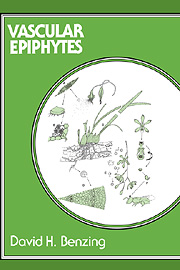4 - Mineral nutrition
Published online by Cambridge University Press: 29 October 2009
Summary
Plant nutritionists have paid little attention to epiphytes, concentrating instead on plants rooted in earth soil. Consequently, consideration of mineral cycling in tropical woodlands has seldom taken into account the potentially major impact of arboreal vegetation. Reports from a scanty but developing literature on epiphytes, together with relevant aspects of plant physiology in other groups, provide a basis for the following chapter. Epiphytes will be portrayed as plants that not only tap a variety of nutrient sources (at times with novel absorptive organs) but also are significant players in the nutrient and energy economies of many tropical forests.
Nutritional categories
All higher plants require at least six macronutrients and seven trace elements for growth (Table 4.1). Some taxa supplement these basic 13 with others that support out-of-the-ordinary functions. For example, many grasses produce silicon-containing granules that reduce palatability to vertebrates; selenium (Se) can act as a sulfur (S) analog, helping to ward off herbivores; some halophytes and all C4 and CAM taxa require sodium (Na); and so on. Descriptive epithets are applied in certain cases: halophytes versus glycophytes, to describe occurrence on hyperosmotic media; calcifuges versus calcicoles, to specify calcium (Ca) content of native soil; eutrophs and oligotrophs, to distinguish quantities of key macronutrients needed.
Eutrophs are characterized by several features. Critical concentrations of foliar N and P (those levels required to maximize growth) tend to be elevated (Table 4.1). Shoot/root ratios are generally high, life cycles and longevity of leaves, brief. Mature size and vigor are tied closely to nutrient supply.
- Type
- Chapter
- Information
- Vascular EpiphytesGeneral Biology and Related Biota, pp. 112 - 151Publisher: Cambridge University PressPrint publication year: 1990
- 1
- Cited by

